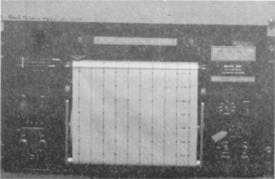Operation
Figure 2-39.—RO-546/GMQ-13 GIFFT cloud height
recorder.
conjunction with the ML-121 ceiling light projector.
Ceiling balloons may also be used to determine cloud
height, both ashore and at sea.
AN/GMQ-13 CLOUD HEIGHT
SET
The AN/GMQ-13 cloud height set was introduced
to the fleet from 1955 to 1959. Over the years many
modifications have been made to the individual pieces
of equipment. Currently, the cloud height set consists of
an ML-506/GMQ-13 rotating beam projector, an ML-
507/GMQ-13 cloud height detector, and an RO-
546/GMQ-13 GIFFT ceiling height recorder. The
projector and the detector are permanently installed
near the main runway, but are separated by a 400- to
900-foot baseline. See figure 2-38 for a standard setup
diagram. The standard baseline is 400 feet. Cloud
height is determined by the angle of the projected light
beam reflected from the base of the clouds directly
overhead the receiver. The GIFFT cloud height
recorder, usually rack-mounted in the observer’s space
(fig. 2-39), records angle-of-reflection on a chart.
Detailed information on the theory of operation,
operating instructions, and maintenance guidance for
the projector and receiver is contained in NA 50-
30GMQ13-1, Handbook, Operation and Service
Instructions, with Illustrated Parts Breakdown, Cloud
Height Set AN/GMQ-13(C). Operation and
maintenance guidance for the RO-546/GMQ-13 GIFFT
recorder is published in the manufacturer’s instructions
provided with the equipment.
Evaluation of the Recorder Trace
The RO-546 recorder chart is marked in hours and
tens of minutes. The time marking "234" equates to
2340Z. Time adjustments are covered in the operator’s
manual.
The procedure used to determine cloud height using
the GIFFT recorder has been refined since the
manufacturer provided the operator’s manual. The
recorder elevation angle is evaluated differently for
various weather conditions. In some cases, the
indicated elevation angle must be corrected to obtain an
accurate cloud-base height.
CORRECTION FACTOR.—An equipment
correction must be determined for each individual
GIFFT recorder before any recorded elevation angles
may be used to determine cloud height. The following
procedure is used for RO-546 recorders when the ML-
506 RBC projector and ML-507 RBC receiver are
separated by the standard, 400-foot, baseline.
To obtain the equipment correction, make a
recording of a high, solid cloud cover with bases
between 10,000 and 20,000 feet. This solid cloud cover
should produce a fairly consistent solid band, 4° to 8°
wide, on the recorder chart. Solid, well-defined cloud
bases will produce a shorter trace, while diffuse or
ragged bases will produce a longer trace. See figure
2-40. The occasional horizontal lines marked outside
Figure 2-40.—Determining equipment correction from high, solid cloud cover.
2-31




